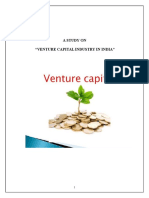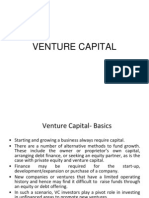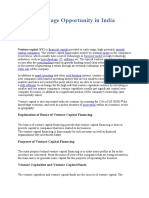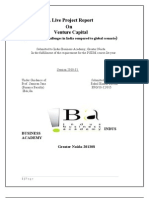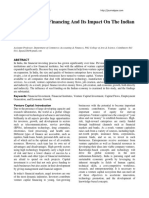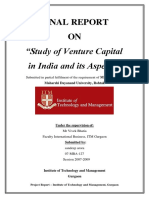Venture Capital in India Overview
Uploaded by
Sanjay YadavVenture Capital in India Overview
Uploaded by
Sanjay YadavMERCHANT BANKING ASSIGNMENT
Venture Capital in India
1. Introduction
A number of technocrats are seeking to set up shop on their own and capitalize on opportunities.
In the highly dynamic economic climate that surrounds us today, few traditional business models
may survive. Countries across the globe are realizing that it is not the conglomerates and the
gigantic corporations that fuel economic growth any more. The essence of any economy, today is
the small and medium enterprises. For example, in the US, 50% of the exports, are created by
companies with less than 20 employees and only 7% are created by companies with 500 or more
employees.
This growing trend can be attributed to rapid advances in technology in the last decade.
Knowledge driven industries like infotech, health-care, entertainment and services have become
the cynosure of bourses worldwide. In these sectors, it is innovation and technical capability that
are big business-drivers. This is a paradigm shift from the earlier physical production and
economies of scale model.
However, starting an enterprise is never easy. There are a number of parameters that contribute
to its success or downfall. Experience, integrity, prudence and a clear understanding of the
market are among the sought after qualities of a promoter. However, there are other factors,
which lie beyond the control of the entrepreneur. Prominent among these is the timely infusion of
funds. This is where the venture capitalist comes in, with money, business sense and a lot more
2. What Is Venture Capital?
Venture capital is money provided by professionals who invest alongside management in young,
rapidly growing companies that have the potential to develop into significant economic
contributors. Venture capital is an important source of equity for start-up companies.
Venture Capital in India
Professionally managed venture capital firms generally are private partnerships or closely-held
corporations funded by private and public pension funds, endowment funds, foundations,
corporations, wealthy individuals, foreign investors, and the venture capitalists themselves.
Venture capitalists generally:
Finance new and rapidly growing companies
Purchase equity securities
Assist in the development of new products or services
Add value to the company through active participation
Take higher risks with the expectation of higher rewards
Have a long-term orientation
When considering an investment, venture capitalists carefully screen the technical and business
merits of the proposed company. Venture capitalists only invest in a small percentage of the
businesses they review and have a long-term perspective. They also actively work with the
company's management, especially with contacts and strategy formulation.
Venture capitalists mitigate the risk of investing by developing a portfolio of young companies in a
single venture fund. Many times they co-invest with other professional venture capital firms. In
addition, many venture partnerships manage multiple funds simultaneously. For decades, venture
capitalists have nurtured the growth of America's high technology and entrepreneurial
communities resulting in significant job creation, economic growth and international
competitiveness. Companies such as Digital Equipment Corporation, Apple, Federal Express,
Compaq, Sun Microsystems, Intel, Microsoft and Genentech are famous examples of companies
that received venture capital early in their development. (Source: National Venture Capital
Association 1999 Yearbook).
In India, these funds are governed by the Securities and Exchange Board of India (SEBI)
guidelines. According to this, venture capital fund means a fund established in the form of a
company or trust, which raises monies through loans, donations, issue of securities or units as
the case may be, and makes or proposes to make investments in accordance with these
regulations. (Source: SEBI (Venture Capital Funds) Regulations, 1996)
3. Investment Philosophy
The basic principal underlying venture capital invest in high-risk projects with the anticipation of
high returns. These funds are then invested in several fledging enterprises, which require funding,
but are unable to access it through the conventional sources such as banks and financial
institutions. Typically first generation entrepreneurs start such enterprises. Such enterprises
generally do not have any major collateral to offer as security, hence banks and financial
institutions are averse to funding them. Venture capital funding may be by way of investment in
the equity of the new enterprise or a combination of debt and equity, though equity is the most
preferred route.
Since most of the ventures financed through this route are in new areas (worldwide venture
capital follows "hot industries" like infotech, electronics and biotechnology), the probability of
success is very low. All projects financed do not give a high return. Some projects fail and some
give moderate returns. The investment, however, is a long-term risk capital as such projects
normally take 3 to 7 years to generate substantial returns. Venture capitalists offer "more than
money" to the venture and seek to add value to the investee unit by active participation in its
management. They monitor and evaluate the project on a continuous basis.
Venture Capital in India
The venture capitalist is however not worried about failure of an investee company, because the
deal which succeeds, nets a very high return on his investments high enough to make up for
the losses sustained in unsuccessful projects. The returns generally come in the form of selling
the stocks when they get listed on the stock exchange or by a timely sale of his stake in the
company to a strategic buyer. The idea is to cash in on an increased appreciation of the share
value of the company at the time of disinvestment in the investee company. If the venture fails
(more often than not), the entire amount gets written off. Probably, that is one reason why venture
capitalists assess several projects and invest only in a handful after careful scrutiny of the
management and marketability of the project.
To conclude, a venture financier is one who funds a start up company, in most cases promoted by
a first generation technocrat promoter with equity. A venture capitalist is not a lender, but an
equity partner. He cannot survive on minimalism. He is driven by maximization: wealth
maximization. Venture capitalists are sources of expertise for the companies they finance. Exit is
preferably through listing on stock exchanges. This method has been extremely successful in
USA, and venture funds have been credited with the success of technology companies in Silicon
Valley. The entire technology industry thrives on it
4. Brief history of Venture Capital
The concept of venture capital is not new. Venture capitalists often relate the story of Christopher
Columbus. In the fifteenth century, he sought to travel westwards instead of eastwards from
Europe and so planned to reach India. His far-fetched idea did not find favor with the King of
Portugal, who refused to finance him. Finally, Queen Isabella of Spain, decided to fund him and
the voyages of Christopher Columbus are now empanelled in history.
The modern venture capital industry began taking shape in the post World War II years. It is
often said that people decide to become entrepreneurs because they see role models in other
people who have become successful entrepreneurs. Much the same thing can be said about
venture capitalists.
5. Venture Capital In India
Most of the success stories of the popular Indian entrepreneurs like the Ambanis and Tatas had
little to do with a professionally backed up investment at an early stage. In fact, till very recently,
for an entrepreneur starting off on his own personal savings or loans raised through personal
contacts/financial institutions.
Traditionally, the role of venture capital was an extension of the developmental financial
institutions like IDBI, ICICI, SIDBI and State Finance Corporations (SFCs). The first origins of
modern Venture Capital in India can be traced to the setting up of a Technology Development
Fund (TDF) in the year 1987-88, through the levy of a cess on all technology import payments.
TDF was meant to provide financial assistance to innovative and high-risk technological
programs through the Industrial Development Bank of India. This measure was followed up in
November 1988, by the issue of guidelines by the (then) Controller of Capital Issues (CCI). These
stipulated the framework for the establishment and operation of funds/companies that could avail
of the fiscal benefits extended to them.
However, another form of (ad?)venture capital which was unique to Indian conditions also
existed. That was funding of green-field projects by the small investor by subscribing to the Initial
Public Offering (IPO) of the companies. Companies like Jindal Vijaynagar Steel, which raised
money even before they started constructing their plants, were established through this route.
Venture Capital in India
The industrys growth in India can be considered in two phases. The first phase was spurred on
soon after the liberalization process began in 1991. According to former finance minister and
harbinger of economic reform in the country, Manmohan Singh, the government had recognized
the need for venture capital as early as 1988. That was the year in which the Technical
Development and Information Corporation of India (TDICI, now ICICI ventures) was set up, soon
followed by Gujarat Venture Finance Limited (GVFL). Both these organizations were promoted by
financial institutions. Sources of these funds were the financial institutions, foreign institutional
investors or pension funds and high net-worth individuals. Though an attempt was also made to
raise funds from the public and fund new ventures, the venture capitalists had hardly any impact
on the economic scenario for the next eight years.
However, it was realized that the concept of venture capital funding needed to be institutionalized
and regulated. This funding requires different skills in assessing the proposal and monitoring the
progress of the fledging enterprise. In 1996, the Securities and Exchange Board of India (SEBI)
came out with guidelines for venture capital funds has to adhere to, in order to carry out activities
in India. This was the beginning of the second phase in the growth of venture capital in India. The
move liberated the industry from a number of bureaucratic hassles and paved the path for the
entry of a number of foreign funds into India. Increased competition brought with it greater access
to capital and professional business practices from the most mature markets.
There are a number of funds, which are currently operational in India and involved in funding
start-up ventures. Most of them are not true venture funds, as they do not fund start-ups. What
they do is provide mezzanine or bridge funding and are better known as private equity players.
However, there is a strong optimistic undertone in the air. With the Indian knowledge industry
finally showing signs of readiness towards competing globally and awareness of venture
capitalists among entrepreneurs higher than ever before, the stage seems all set for an overdrive.
The Indian Venture Capital Association (IVCA), is the nodal center for all venture activity in the
country. The association was set up in 1992 and over the last few years, has built up an
impressive database. According to the IVCA, the pool of funds available for investment to its 20
members in 1997 was Rs25.6bn. Out of this, Rs10 bn had been invested in 691 projects.
Certain venture capital funds are Industry specific(ie they fund enterprises only in certain
industries such as pharmaceuticals, infotech or food processing) whereas others may have a
much wider spectrum. Again, certain funds may have a geographic focus like Uttar Pradesh,
Maharashtra, Kerala, etc whereas others may fund across different territories. The funds may be
either close-endedschemes (with a fixed period of maturity) or open-ended.
Classification
Venture funds in India can be classified on the basis of
Genesis
Financial Institutions Led By ICICI Ventures, RCTC, ILFS, etc.
Private venture funds like Indus, etc.
Regional funds like Warburg Pincus, JF Electra (mostly operating out of Hong Kong).
Regional funds dedicated to India like Draper, Walden, etc.
Offshore funds like Barings, TCW, HSBC, etc.
Corporate ventures like Intel.
Venture Capital in India
To this list we can add Angels like Sivan Securities, Atul Choksey (ex Asian Paints) and others.
Merchant bankers and NBFCs who specialized in "bought out" deals also fund companies. Most
merchant bankers led by Enam Securities now invest in IT companies.
Investment Philosophy
Early stage funding is avoided by most funds apart from ICICI ventures, Draper, SIDBI and
Angels.
Funding growth or mezzanine funding till pre IPO is the segment where most players operate. In
this context, most funds in India are private equity investors.
Size of Investment
The size of investment is generally less than US$1mn, US$1-5mn, US$5-10mn, and greater than
US$10mn. As most funds are of a private equity kind, size of investments has been increasing. IT
companies generally require funds of about Rs30-40mn in an early stage which fall outside
funding limits of most funds and that is why the government is promoting schemes to fund start
ups in general, and in IT in particular.
Value Addition
The venture funds can have a totally "hands on" approach towards their investment like Draper or
"hands off" like Chase. ICICI Ventures falls in the limited exposure category. In general, venture
funds who fund seed or start ups have a closer interaction with the companies and advice on
strategy, etc while the private equity funds treat their exposure like any other listed investment.
This is partially justified, as they tend to invest in more mature stories.
A list of the members registered with the IVCA as of June 1999, has been provided in the
Annexure. However, in addition to the organized sector, there are a number of players operating
in India whose activity is not monitored by the association. Add together the infusion of funds by
overseas funds, private individuals, angel investors and a host of financial intermediaries and the
total pool of Indian Venture Capital today, stands at Rs50bn, according to industry estimates!
The primary markets in the country have remained depressed for quite some time now. In the last
two years, there have been just 74 initial public offerings (IPOs) at the stock exchanges, leading
to an investment of just Rs14.24bn. Thats less than 12% of the money raised in the previous two
years. That makes the conservative estimate of Rs36bn invested in companies through the
Venture Capital/Private Equity route all the more significant.
Some of the companies that have received funding through this route include:
Mastek, one of the oldest software houses in India
Geometric Software, a producer of software solutions for the CAD/CAM market
Ruksun Software, Pune-based software consultancy
SQL Star, Hyderabad based training and software development company
Microland, networking hardware and services company based in Bangalore
Satyam Infoway, the first private ISP in India
Hinditron, makers of embedded software
Venture Capital in India
PowerTel Boca, distributor of telecomputing products for the Indian market
Rediff on the Net, Indian website featuring electronic shopping, news, chat, etc
Entevo, security and enterprise resource management software products
Planetasia.com, Microlands subsidiary, one of Indias leading portals
Torrent Networking, pioneer of Gigabit-scaled IP routers for inter/intra nets
Selectica, provider of interactive software selection
Yantra, ITLInfosys US subsidiary, solutions for supply chain management
Though the infotech companies are among the most favored by venture capitalists, companies
from other sectors also feature equally in their portfolios. The healthcare sector with
pharmaceutical, medical appliances and biotechnology industries also get much attention in India.
With the deregulation of the telecom sector, telecommunications industries like Zip Telecom and
media companies like UTV and Television Eighteen have joined the list of favorites. So far, these
trends have been in keeping with the global course.
However, recent developments have shown that India is maturing into a more developed
marketplace, unconventional investments in a gamut of industries have sprung up all over the
country. This includes:
Indus League Clothing, a company set up by eight former employees of readymade garments
giant Madura, who set up shop on their own to develop a unique virtual organization that will
license global apparel brands and sell them, without owning any manufacturing units. They dream
to build a network of 2,500 outlets in three years and to be among the top three readymade
brands.
Shoppers Stop, Mumbais premier departmental store innovates with retailing and decides to go
global. This deal is facing some problems in getting regulatory approvals.
Airfreight, the courier-company which has been growing at a rapid pace and needed funds for
heavy investments in technology, networking and aircrafts.
Pizza Corner, a Chennai based pizza delivery company that is set to take on global giants like
Pizza Hut and Dominos Pizza with its innovative servicing strategy.
Car designer Dilip Chhabria, who plans to turn his studio, where he remodels and overhauls cars
into fancy designer pieces of automation, into a company with a turnover of Rs1.5bn (up from
Rs40mn today).
6. Indian Scenario - A Statistical Snapshot
In India, reliable estimates of VC funding are also difficult, mostly because not all that is reported
is real and because rules allow many VC transactions to fall outside official statistics by making
them indistinguishable from routine foreign investment. Still, there is broad agreement that VC
funding in India in the calendar year 2003 was in the $500-600 million range, a sharp drop from
$1.1 billion in 2002 and $900 million in 2001. Over 80 per cent new VC investment in India is in
profitable companies rather than start-ups, with Internet companies clearly out of favour and
BPO, media, entertainment and healthcare emerging as the new stars.
But Indian VC investment, for all its brouhaha, is essentially small, far less than China and Japan,
and far less exciting. In fact, India has now slipped to the 5th position (from 3rd place in 2002) in
Asia. More than the dotcom bust, this is perhaps due to the belated realisation that India remains
Venture Capital in India
an untested if not shaky market, and that success is often shaped by a combination of social
circumstance and government role.
Take vaccines for instance, where a number of firms are in the race. On surface, the market
opportunity looks huge; after all, infant mortality is high in India, over 3 million children under the
age of five die each year and one in every 15 persons is a carrier of some immunisable disease.
But while vaccine sales are robust and growing, around 20 per cent annually, they have hardly
shown the dramatic growth that was projected by many venture capitalists.
Why? Because government is still the largest buyer. Official procurement remains mired in
bureaucracy and corruption, while refrigeration and medical infrastructure needed for an effective
immunisation programme simply does not exist in the far reaches of the country. The bottomline
is that no matter how fantastic a discovery, a new vaccine will enjoy only limited market
penetration due to the meagre resources of the public health system.
Venture and technology people (there is an 80 per cent overlap) are not stupid but they operate
under far less checks and balances than do others. The business by its nature is very lonely, the
rush to spot novel ideas and emerging technologies is both consuming and seductive, and there
are few markers to help along the way. All these push VCs to believing in their own destiny.
Confidence and risk-taking are essential for creating wealth, but not if you act as if you just had a
conversation with God. Combined Indian industry estimates speak of reaching $1.5 billion
financing in 2004, but more than quantity we need to focus on the quality and impact of this
capital.
An estimated $17.5 billion of private equity and venture capital was invested in the Asia
Pacific region in 2003-a whopping 92% increase on 2002
Japan led the region accounting for $7.3bn of the value of deals completed, followed by
Korea with $3.3bn and Australia with $2.8bn
In contrast, only $3.32 billion of new funds were raised in 2003 (up only 10% on 2002
levels)
The pool of private equity capital under management rose to $97.6 billion in 2003 up from
$88.6bn in 2002
Start-up and early stage investment is estimated at $ 0.6 bn and $1.4 billion was invested
in expansion stage companies in 2003
Telecommunication section had the highest percentage of invested capital with $3.7bn or
21% followed by financial services with $2.3bn or 18.3%
India Venture Capital investment trends:
Venture Capital in India
Indu
stry
estimates indicate that VC funding during January-March 2001 has declined by as much as 50%
over the same period during 2000. The decline is especially significant in ventures in businessto-consumer (b2c), Internet solutions and ERP/accounting software.
The decline in VC funding is because of various factors including the general slowdown in the
global economy, depressed state of the stock markets3, decline in new capital issues4, sharp
decline in valuation of technology stocks, venture capitalists spending more time with their
current portfolio companies and a decline in interest in e-commerce and Internet related IPOs.
Venture capitalists have invested a significant amount into e-commerce and content ventures.
Because of competition for deals, many funded companies had received financing at
excessive valuations. However, negative cash generation at a majority of these ventures has
necessitated a further round of financing.
Venture Capital in India
Contributors of Funds
Contributors
Rs mn
Per cent
Foreign Institutional Investors
13,426.47
52.46%
All India Financial Institutions
6,252.90
24.43%
Multilateral Development Agencies
2,133.64
8.34%
Other Banks
1,541.00
6.02%
Foreign Investors
570
2.23%
Private Sector
412.53
1.61%
Public Sector
324.44
1.27%
Nationalized Banks
278.67
1.09%
Non Resident Indians
235.5
0.92%
State Financial Institutions
215
0.84%
Other Public
115.52
0.45%
Insurance Companies
85
0.33%
Mutual Funds
4.5
0.02%
Total
25,595.17
100.00%
Methods of Financing
Instruments
Rs million
Per cent
Equity Shares
6,318.12
63.18
Redeemable Preference Shares
2,154.46
21.54
Non Convertible Debt
873.01
8.73
Convertible Instruments
580.02
5.8
Other Instruments
75.85
0.75
Total
10,000.46
100
Financing By Investment Stage
Investment Stages
Rs million
Number
Start-up
3,813.00
297
Later stage
3,338.99
154
Other early stage
1,825.77
124
Seed stage
963.2
107
Turnaround financing
59.5
Total
10,000.46
691
Industry
Rs million
Number
Industrial products, machinery
2,599.32
208
Financing By Industry
Venture Capital in India
10
Computer Software
1,832
87
Consumer Related
1,412.74
58
Medical
623.8
44
Food, food processing
500.06
50
Other electronics
436.54
41
Tel & Data Communications
385.09
16
Biotechnology
376.46
30
Energy related
249.56
19
Computer Hardware
203.36
25
Miscellaneous
1,380.85
113
Total
10,000.46
691
Rs million
Number
2,566
161
1531
119
1372
89
1102
49
1046
93
312
22
300
22
294
21
283
29
231
135
15
105
16
87
11
84
35
32
28
22
Financing By States
Investment
Maharashtra
Tamil Nadu
Andhra Pradesh
Gujarat
Karnataka
West Bengal
Haryana
Delhi
Uttar Pradesh
Madhya Pradesh
Kerala
Goa
Rajasthan
Punjab
Orissa
Dadra & Nagar Haveli
Himachal Pradesh
Pondicherry
Venture Capital in India
Bihar
Overseas
Total
11
16
413
12
9994
691
Source IVCA
7. Problems With VCs In The Indian Context
One can ask why venture funding is so successful in USA and faced a number of problems in
India. The biggest problem was a mindset change from "collateral funding" to high risk high return
funding. Most of the pioneers in the industry were people with credit background and exposure to
manufacturing industries. Exposure to fast growing intellectual property business and services
sector was almost zero. All these combined to a slow start to the industry. The other issues that
led to such a situation include:
License Raj And The IPO Boom
Till early 90s, under the license raj regime, only commodity centric businesses thrived in a deficit
situation. To fund a cement plant, venture capital is not needed. What was needed was ability to
get a license and then get the project funded by the banks and DFIs. In most cases, the
promoters were well-established industrial houses, with no apparent need for funds. Most of
these entities were capable of raising funds from conventional sources, including term loans from
institutions and equity markets.
Scalability
The Indian software segment has recorded an impressive growth over the last few years and
earns large revenues from its export earnings, yet our share in the global market is less than 1
per cent. Within the software industry, the value chain ranges from body shopping at the bottom
to strategic consulting at the top. Higher value addition and profitability as well as significant
market presence take place at the higher end of the value chain. If the industry has to grow
further and survive the flux it would only be through innovation. For any venture idea to succeed
there should be a product that has a growing market with a scalable business model. The IT
industry (which is most suited for venture funding because of its "ideas" nature) in India till
recently had a service centric business model. Products developed for Indian markets lack scale.
Mindsets
Venture capital as an activity was virtually non-existent in India. Most venture capital companies
want to provide capital on a secured debt basis, to established businesses with profitable
operating histories. Most of the venture capital units were offshoots of financial institutions and
banks and the lending mindset continued. True venture capital is capital that is used to help
launch products and ideas of tomorrow. Abroad, this problem is solved by the presence of `angel
investors. They are typically wealthy individuals who not only provide venture finance but also
help entrepreneurs to shape their business and make their venture successful.
Returns, Taxes and Regulations
There is a multiplicity of regulators like SEBI and RBI. Domestic venture funds are set up under
the Indian Trusts Act of 1882 as per SEBI guidelines, while offshore funds routed through
Mauritius follow RBI guidelines. Abroad, such funds are made under the Limited Partnership Act,
Venture Capital in India
12
which brings advantages in terms of taxation. The government must allow pension funds and
insurance companies to invest in venture capitals as in USA where corporate contributions to
venture funds are large.
Exit
The exit routes available to the venture capitalists were restricted to the IPO route. Before
deregulation, pricing was dependent on the erstwhile CCI regulations. In general, all issues were
under priced. Even now SEBI guidelines make it difficult for pricing issues for an easy exit. Given
the failure of the OTCEI and the revised guidelines, small companies could not hope for a BSE/
NSE listing. Given the dull market for mergers and acquisitions, strategic sale was also not
available.
Valuation
The recent phenomenon is valuation mismatches. Thanks to the software boom, most promoters
have sky high valuation expectations. Given this, it is difficult for deals to reach financial closure
as promoters do not agree to a valuation. This coupled with the fancy for software stocks in the
bourses means that most companies are preponing their IPOs. Consequently, the number and
quality of deals available to the venture funds gets reduced.
Angels
Angels are important links in the entire process of venture capital funding. This is because they
support a fledging enterprise at a very early stage sometime even before commercialization of
the product or service offering. Typically, an angel is an experienced industry-bred individual with
high net worth.
Angels provide funding by "first round" financing for risky investments risky because they are a
young /start-up company or because their financial track record is unstable. This venture capital
financing is typically used to prepare the company for "second round" financing in the form of an
initial public offering (IPO). Example A company may need "first round" financing to develop a
new product line, (viz a new drug which would require significant research & development
funding) or make a strategic acquisition to achieve certain levels of growth & stability.
It is important to choose the right Angel because they will sit on your Board of Directors, often for
the duration of their investment and will assist in getting "second round" financing. When
choosing an 'Angel', it is imperative to consider their experience in a relevant industry, reputation,
qualifications and track record.
Angels are people with less money orientation, but who play an active role in making an earlystage company work. They are people with enough hands-on experience and are experts in their
fields. They understand the field from an operational perspective. An entrepreneur needs this kind
of expertise. He also needs money to make things happen. Angels bring both to the table of an
entrepreneur.
There are a number of professionally qualified people, especially from IITs who had migrated to
USA. Some of them have made their millions riding the IT boom in Silicon Valley. Having
witnessed the maturity of the Silicon Valley into the global tech hotspot and thrived in the
environment there, these individuals are rich in terms of financial resources and experience. They
are the latest angels in the Indian industry.
Venture Capital in India
13
The IndUS Entrepreneurs (TiE), a networking society that brings together highly influential Indians
across the US was set up in 1992. The aim of the organization is to get the community together
and to foster entrepreneurs and wealth creation. The idea was sparked off in 1992, when a group
of Silicon Valley entrepreneurs with roots in the Indian sub-continent met by chance for a meeting
with a visiting dignitary from India. A delayed flight kept the group waiting, and provided an
opportunity for people to get to know one another. It turned out that most of the assembled
invitees to the meeting had achieved varying degrees of entrepreneurial success. The group saw
value in getting together on a regular basis to network with one another. Thus, the idea of TiE was
born as a mechanism for high achievement-oriented IndUS entrepreneurs to network.
Over the years, a core group of about 10-15 individuals worked hard to establish the organization.
Meeting at least once a month, successful veteran entrepreneurs, contributed as speakers,
participants and mentors. Gradually, the group started attracting greater participation, and the TiE
concept started gaining momentum. TiE membership has now grown to over 600 members, and
chapters in Boston, Austin and Los Angeles. TiE is also supported by over 20 institutions that
include leading Silicon Valley venture capital investors, law firms, accounting firms and banks.
Fifty percent of business plans submitted to venture capitalists in the Valley and outside is now
from Indians and TiE can take the lion's share of the credit for this. What's more? About 30 per
cent of the projects that are funded, are headed by Indians. As of 1998, over two dozen start-up
companies have benefited from TiE, and two have already made successful IPOs.
TiE isn't about venture capitalist funding. It's about angel investing. The issue here is to identify a
good idea that hasn't attracted any money, and then fund it the money coming from the member's
own pockets. The environment is traditional in the sense of it following a gurukul environment of
sorts, where the gurus transfer knowledge on business plans, management strategies and
survival kits to new TiE members.
Some of the famous names include
Vinod Dham, father of the Pentium chip and now the CEO of the Silicon Spice, one of
the most closely watched start-ups in the Silicon Valley today.
Sailesh Mehta, CEO & President of the US$15bn Providian Financial and the man who
is using technology to re-order consumer finance.
Kanwal Rekhi, one of the first Indians to become a big name in the valley; founder of
Excelan, past CTO and member of Novell's board, now invests in a number of new
ventures. He is the current chairman of the TiE.
Prabhu Goel, serial entrepreneur, who has started three hi-tech companies so far and
is on the board of five other companies as a private investor.
Suhas Patil, who founded the semiconductor company Cirrus Logic in 1984.
Prakash Agarwal, whose NeoMagic integrates memory and logic on a single chip. The
six year old company already has a market share of 50%.
K.B. Chandrashekhar, heads the US$200mn Exodus Communications, whose fiber
optic network carries 30% of all Internet content traffic and whose servers host such
popular websites such as Yahoo, Hotmail and Amazon
8. Corporate Venturing
Even though corporate venturing is an attractive alternative, most companies find it difficult to
establish systems, capabilities and cultures that make good venture capital firms. Corporate
managers seldom have the same freedom to fund innovative projects or to cancel them
midstream. Their skills are honed for managing mature businesses and not nurturing start up
companies. If a firm is to apply the venture capital model, it must understand the characteristics of
Venture Capital in India
14
the model and tailor its venture capital program to its own circumstances without losing sight of
these essentials.
Success of venture capital firms rest on the following characteristics:
Focus on specific industry niches and look for business concepts that will
Although corporate managers have a clear focus in their business, they run into
ambiguity with venture programs. Their biggest challenge is to establish clear, prioritized
objectives. Simply making a good financial return is not sufficient.
Manage portfolios ruthlessly, abandon losers, whereas abandoning ventures has never
been easy for large corporations, whose projects are underpinned by personal
relationships, political concerns.
Venture capital firms share several attributes with start up they fund. They tend to be
small, flexible and quick to make decisions. They have flat hierarchies and rely heavily on
equity and incentive pay.
Apple Computers established a venture fund in 1986 with the dual objectives of earning high
financial return and supporting development of Macintosh software. They structured
compensation mechanisms, decision criteria and operating procedures on those of top venture
capital firms. While they considered Macintosh as an initial screening factor, its funding decisions
were aimed at optimizing financial returns. The result was an IRR of 90 per cent but little success
in improving the position of Macintosh.
New ventures can be powerful source of revenues, diversification and flexibility in rapidly
changing environments. The company should create an environment that encourages venturing.
An innovative culture cannot be transplanted but must evolve within the company. Venture
investing requires different mindset from typical corporate investors.
How relevant is corporate venturing in the Indian scenario? The firms, which launched the
successful corporate ventures had created new products in the market operating at the higher
end of the value chain and had attained a certain size in the market. Most Indian companies are
yet to move up the value chain and consolidate their position as players in the global market.
Corporate venturing models would probably benefit Indian companies who are large players in
the Indian market in another five to 10 years by enabling them to diversify and at the same time
help start up companies. Multinationals led by Intel are the best examples of corporate venturing
in an Indian context
9. Financing Options In General
The possibility of raising a substantial part of project finances in India through both equity and
debt instruments is among the key advantages of investing in India.
The Indian banking system has shown remarkable growth over the last two decades. The rapid
growth and increasing complexity of the financial markets, especially the capital market have
brought about measures for further development and improvement in the working of these
markets. Banks and development financial institutions led by ICICI, IDBI and IFCI were providers
of term loans for funding projects. The options were limited to conventional businesses, ie
manufacturing centric. Services sector was ignored because of the "collateral" issue.
Venture Capital in India
15
Equity was raised from the capital markets using the IPO route. The bull markets of the 90s,
fuelled by Harshad Mehta and the FIIs, ensured that (ad)venture capital was easily available.
Manufacturing companies exploited this to the full.
The services sector was ignored, like software, media, etc. Lack of understanding of these
sectors was also responsible for the same. If we look back to 1991 or even 1992, the situation as
regards financial outlay available to Indian software companies was poor. Most software
companies found it extremely difficult to source seed capital, working capital or even venture
capital. Most software companies started off undercapitalized, and had to rely on loans or
overdraft facilities to provide working capital. This approach forced them to generate revenue in
the short term, rather than investing in product development. The situation fortunately has
changed
10. The Venture Capital Process
Venture capitalists are a busy lot. This chapter aims to highlight the approach to an investor and
the entire process that goes into the wooing the venture capital with your plan.
First, you need to work out a business plan. The business plan is a document that outlines the
management team, product, marketing plan, capital costs and means of financing and profitability
statements.
The venture capital investment process has variances/features that are context specific and vary
from industry, timing and region. However, activities in a venture capital fund follow a typical
sequence. The typical stages in an investment cycle are as below:
Generating a deal flow
Due diligence
Investment valuation
Pricing and structuring the deal
Value Addition and monitoring
Exit
Generating A Deal Flow
In generating a deal flow, the venture capital investor creates a pipeline of deals or investment
opportunities that he would consider for investing in. This is achieved primarily through plugging
into an appropriate network. The most popular network obviously is the network of venture capital
funds/investors. It is also common for venture capitals to develop working relationships with R&D
institutions, academia, etc, which could potentially lead to business opportunities. Understandably
the composition of the network would depend on the investment focus of the venture capital
funds/company. Thus venture capital funds focussing on early stage technology based deals
would develop a network of R&D centers working in those areas. The network is crucial to the
success of the venture capital investor. It is almost imperative for the venture capital investor to
receive a large number of investment proposals from which he can select a few good investment
candidates finally. Successful venture capital investors in the USA examine hundreds of business
plans in order to make three or four investments in a year.
It is important to note the difference between the profile of the investment opportunities that a
venture capital would examine and those pursued by a conventional credit oriented agency or an
investment institution. By definition, the venture capital investor focuses on opportunities with a
high degree of innovation.
Venture Capital in India
16
The deal flow composition and the technique of generating a deal flow can vary from country to
country. In India, different venture capital funds/companies have their own methods varying from
promotional seminars with R&D institutions and industry associations to direct advertising
campaigns targeted at various segments. A clear pattern between the investment focus of a fund
and the constitution of the deal generation network is discernible even in the Indian context.
Due Diligence
Due diligence is the industry jargon for all the activities that are associated with evaluating an
investment proposal. It includes carrying out reference checks on the proposal related aspects
such as management team, products, technology and market. The important feature to note is
that venture capital due diligence focuses on the qualitative aspects of an investment opportunity.
It is also not unusual for venture capital fund/companies to set up an investment screen. The
screen is a set of qualitative (sometimes quantitative criteria such as revenue are also used)
criteria that help venture capital funds/companies to quickly decide on whether an investment
opportunity warrants further diligence. Screens can be sometimes elaborate and rigorous and
sometimes specific and brief. The nature of screen criteria is also a function of investment focus
of the firm at that point. Venture capital investors rely extensively on reference checks with
leading lights in the specific areas of concern being addressed in the due diligence.
A venture capitalist tries to maximize the upside potential of any project. He tries to structure his
investment in such a manner that he can get the benefit of the upside potential ie he would like to
exit at a time when he can get maximum return on his investment in the project. Hence his due
diligence appraisal has to keep this fact in mind.
New Financing
Sometimes, companies may have experienced operational problems during their early stages of
growth or due to bad management. These could result in losses or cash flow drains on the
company. Sometimes financing from venture capital may end up being used to finance these
losses. They avoid this through due diligence and scrutiny of the business plan.
Inter-Company Transactions
When investments are made in a company that is part of a group, inter-company transactions
must be analyzed.
Investment Valuation
The investment valuation process is an exercise aimed at arriving at an acceptable price for the
deal. Typically in countries where free pricing regimes exist, the valuation process goes through
the following steps:
Evaluate future revenue and profitability
Forecast likely future value of the firm based on experienced market capitalization or
expected acquisition proceeds depending upon the anticipated exit from the investment.
Target an ownership position in the investee firm so as to achieve desired appreciation on
the proposed investment. The appreciation desired should yield a hurdle rate of return on
a Discounted Cash Flow basis.
Symbolically the valuation exercise may be represented as follows:
Venture Capital in India
17
NPV = [(Cash)/(Post)] x [(PAT x PER)] x k, where
NPV = Net Present Value of the cash flows relating to the investment comprising outflow
by way of investment and inflows by way of interest/dividends (if any) and realization on
exit. The rate of return used for discounting is the hurdle rate of return set by the venture
capital investor.
Post = Pre + Cash
Cash represents the amount of cash being brought into the particular round of financing
by the venture capital investor.
Pre is the pre-money valuation of the firm estimated by the investor. While technically it
is measured by the intrinsic value of the firm at the time of raising capital. It is more often
a matter of negotiation driven by the ownership of the company that the venture capital
investor desires and the ownership that founders/management team is prepared to give
away for the required amount of capital
PAT is the forecast Profit after tax in a year and often agreed upon by the founders and
the investors (as opposed to being arrived at unilaterally). It would also be the net of
preferred dividends, if any.
PER is the Price-Earning multiple that could be expected of a comparable firm in the
industry. It is not always possible to find such a comparable fit in venture capital
situations. That necessitates, therefore, a significant degree of judgement on the part of
the venture capital to arrive at alternate PER scenarios.
k is the present value interest factor (corresponding to a discount rate r) for the
investment horizon.
It is quite apparent that PER time PAT represents the value of the firm at that time and the
complete expression really represents the investors share of the value of the investee firm. The
following example illustrates this framework:
Example: Best Mousetrap Limited (BML) has developed a prototype that needs to be
commercialized. BML needs cash of Rs2mn to establish production facilities and set up a
marketing program. BML expects the company will go public in the third year and have revenues
of Rs70mn and a PAT margin of 10% on sales. Assume, for the sake of convenience that there
would be no further addition to the equity capital of the company.
Prudent Fund Managers (PFM) propose to lead a syndicate of like minded investors with a hurdle
rate of return of 75% (discounted) over a five year period based on BMLs sales and profitability
expectations. Firms with comparable sales and profitability and risk profiles trade at 12 times
earnings on the stock exchange. The following would be the sequence of computations:
In order to get a 75% return p.a. the initial investment of Rs2 million must yield an accumulation
of 2 x (1.75)5 = Rs32.8mn on disinvestment in year 5.
BMLs market capitalization in five years is likely to be Rs (70 x 0.1 x 12) million = Rs84mn.
Percentage ownership in BML that is required to yield the desired accumulation will be (32.8/84) x
100 = 39%
Therefore the post money valuation of BML At the time of raising capital will be equal to
Rs(2/0.39) million = Rs5.1 million which implies that a pre-money valuation of Rs3.1 million for
BML
Venture Capital in India
18
Another popular variant of the above method is the First Chicago Method (FCM) developed by
Stanley Golder, a leading professional venture capital manager. FCM assumes three possible
scenarios success, sideways survival and failure. Outcomes under these three scenarios are
probability weighted to arrive at an expected rate of return:
In reality the valuation of the firm is driven by a number of factors. The more significant among
these are:
Overall economic conditions: A buoyant economy produces an optimistic long- term outlook for
new products/services and therefore results in more liberal pre-money valuations.
Demand and supply of capital: when there is a surplus of venture capital of venture
capital chasing a relatively limited number of venture capital deals, valuations go up. This
can result in unhealthy levels of low returns for venture capital investors.
Specific rates of deals: such as the founders/management teams track record,
innovation/ unique selling propositions (USPs), the product/service size of the potential
market, etc affects valuations in an obvious manner.
The degree of popularity of the industry/technology in question also influences the premoney. Computer Aided Skills Software Engineering (CASE) tools and Artificial
Intelligence were one time darlings of the venture capital community that have now given
place to biotech and retailing.
The standing of the individual venture capital Well established venture capitals who are
sought after by entrepreneurs for a number of reasons could get away with tighter
valuations than their less known counterparts.
Investors considerations could vary significantly. A study by an American venture capital,
VentureOne, revealed the following trend. Large corporations who invest for strategic
advantages such as access to technologies, products or markets pay twice as much as a
professional venture capital investor, for a given ownership position in a company but
only half as much as investors in a public offering.
Valuation offered on comparable deals around the time of investing in the deal.
Quite obviously, valuation is one of the most critical activities in the investment process. It would
not be improper to say that the success for a fund will be determined by its ability to value/price
the investments correctly.
Sometimes the valuation process is broadly based on thumb rule metrics such as multiple of
revenue. Though such methods would appear rough and ready, they are often based on fairly
well established industry averages of operating profitability and assets/capital turnover ratios
Such valuation as outlined above is possible only where complete freedom of pricing is available.
In the Indian context, where until recently, the pricing of equity issues was heavily regulated,
unfortunately valuation was heavily constrained.
Structuring A Deal
Structuring refers to putting together the financial aspects of the deal and negotiating with the
entrepreneurs to accept a venture capitals proposal and finally closing the deal. To do a good job
in structuring, one needs to be knowledgeable in areas of accounting, cash flow, finance, legal
and taxation. Also the structure should take into consideration the various commercial issues (ie
what the entrepreneur wants and what the venture capital would require to protect the
investment). Documentation refers to the legal aspects of the paperwork in putting the deal
together.
Venture Capital in India
19
The instruments to be used in structuring deals are many and varied. The objective in selecting
the instrument would be to maximize (or optimize) venture capitals returns/protection and yet
satisfy the entrepreneurs requirements. The instruments could be as follows:
Instrument
Issues
Loan
clean vs secured
Interest bearing vs non interest bearing
convertible vs one with features (warrants)
1st Charge, 2nd Charge,
loan vs loan stock
maturity
Preference shares
redeemable (conditions under Company Act)
participating
par value
nominal shares
Warrants
exercise price, expiry period
Common shares
new or vendor shares
par value
partially-paid shares
Options
exercise price, expiry period, call, put
In India, straight equity and convertibles are popular and commonly used. Nowadays, warrants
are issued as a tool to bring down pricing.
A variation that was first used by PACT and TDICI was "royalty on sales". Under this, the
company was given a conditional loan. If the project was successful, the company had to pay a %
age of sales as royalty and if it failed then the amount was written off.
In structuring a deal, it is important to listen to what the entrepreneur wants, but the venture
capital comes up with his own solution. Even for the proposed investment amount, the venture
capital decides whether or not the amount requested, is appropriate and consistent with the risk
level of the investment. The risks should be analyzed, taking into consideration the stage at which
the company is in and other factors relating to the project. (eg exit problems, etc).
Promoter Shares
As venture capital is to finance growth, venture capital investment should ideally be used for
financing expansion projects (eg new plant, capital equipment, additional working capital). On the
other hand, entrepreneurs may want to sell away part of their interests in order to lock-in a profit
for their work in building up the company. In such a case, the structuring may include some
vendor shares, with the bulk of financing going into buying new shares to finance growth.
Handling Directors And Shareholders Loans
Venture Capital in India
20
Frequently, a company has existing directors and shareholders loans prior to inviting venture
capitalists to invest. As the money from venture capital is put into the company to finance growth,
it is preferable to structure the deal to require these loans to be repaid back to the
shareholders/directors only upon IPOs/exits and at some mutually agreed period (eg 1 or 2 years
after investment). This will increase the financial commitment of the entrepreneur and the
shareholders of the project.
A typical proposal may include a combination of several different instruments listed above. Under
normal circumstances, entrepreneurs would prefer venture capitals to invest in equity as this
would be the lowest risk option for the company. However from the venture capitals point of view,
the safest instrument, but with the least return, would be a secured loan. Hence, ultimately, what
you end up with would be some instruments in between which are sold to the entrepreneur.
Monitoring And Follow Up
The role of the venture capitalist does not stop after the investment is made in the project. The
skills of the venture capitalist are most required once the investment is made. The venture
capitalist gives ongoing advice to the promoters and monitors the project continuously.
It is to be understood that the providers of venture capital are not just financiers or subscribers to
the equity of the project they fund. They function as a dual capacity, as a financial partner and
strategic advisor. Venture capitalists monitor and evaluate projects regularly. They keep a hand
on the pulse of the project. They are actively involved in the management of the of the investee
unit and provide expert business counsel, to ensure its survival and growth. Deviations or causes
of worry may alert them to potential problems and they can suggest remedial actions or measures
to avoid these problems. As professional in this unique method of financing, they may have
innovative solutions to maximize the chances of success of the project. After all, the ultimate aim
of the venture capitalist is the same as that of the promoters the long term profitability and
viability of the investee company.
Exit
One of the most crucial issues is the exit from the investment. After all, the return to the venture
capitalist can be realized only at the time of exit. Exit from the investment varies from the
investment to investment and from venture capital to venture capital. There are several exit
routes, buy-buck by the promoters, sale to another venture capitalist or sale at the time of Initial
Public Offering, to name a few. In all cases specialists will work out the method of exit and decide
on what is most profitable and suitable to both the venture capitalist and the investee unit and the
promoters of the project.
At present many investments of venture capitalists in India remain on paper as they do not have
any means of exit. Appropriate changes have to be made to the existing systems in order that
venture capitalists find it easier to realize their investments after holding on to them for a certain
period of time. This factor is even more critical to smaller and mid sized companies, which are
unable to get listed on any stock exchange, as they do not meet the minimum requirements for
such listings. Stock exchanges could consider how they could assist in this matter for listing of
companies keeping in mind the requirement of the venture capital industry
11. Accessing Venture Capital
Venture Capital in India
21
Venture funds, both domestic and offshore, have been around in India for some years now.
However it is only in the past 12 to 18 months, they have come into the limelight. The rejection
ratio is very high, about 10 in 100 get beyond pre evaluation stage, and 1 gets funded.
Venture capital funds are broadly of two kinds - generalists or specialists. It is critical for the
company to access the right type of fund, ie who can add value. This backing is invaluable as
focused/specialized funds open doors, assist in future rounds and help in strategy. Hence, it is
important to choose the right venture capitalist.
The standard parameters used by venture capitalists are very similar to any investment decision.
The only difference being exit. If one buys a listed security, one can exit at a price but with an
unlisted security, exit becomes difficult. The key factors which they look for in
The Management
Most businesses are people driven, with success or failure depending on the performance of the
team. It is important to distinguish the entrepreneur from the professional management team. The
value of the idea, the vision, putting the team together, getting the funding in place are amongst
others, some key aspects of the role of the entrepreneur. Venture capitalists will insist on a
professional team coming in, including a CEO to execute the idea. One-man armies are passe.
Integrity and commitment are attributes sought for. The venture capitalist can provide the
strategic vision, but the team executes it. As a famous Silicon Valley saying goes "Success is
execution, strategy is a dream".
The Idea
The idea and its potential for commercialization are critical. Venture funds look for a scalable
model, at a country or a regional level. Otherwise the entire game would be reduced to a
manpower or machine multiplication exercise. For example, it is very easy for Hindustan Lever to
double sales of Liril - a soap without incremental capex, while Gujarat Ambuja needs to spend at
least Rs4bn before it can increase sales by 1mn ton. Distinctive competitive advantages must
exist in the form of scale, technology, brands, distribution, etc which will make it difficult for
competition to enter.
Valuation
All investment decisions are sensitive to this. An old stock market saying "Every stock is a buy at
a price and vice versa". Most deals fail because of valuation expectation mismatch. In India, while
calculating returns, venture capital funds will take into account issues like rupee depreciation,
political instability, which adds to the risk premia, thus suppressing valuations. Linked to valuation
is the stake, which the fund takes. In India, entrepreneurs are still uncomfortable with the venture
capital "taking control" in a seed stage project.
Exit
Without exit, gains cannot be booked. Exit may be in the form of a strategic sale or/and IPO.
Taxation issues come up at the time. Any fund would discuss all exit options before closing a
deal. Sometimes, the fund insists on a buy back clause to ensure an exit.
Portfolio Balancing
Venture Capital in India
22
Most venture funds try and achieve portfolio balancing as they invest in different stages of the
company life cycle. For example, a venture capital has invested in a portfolio of companies
predominantly at seed stage, they will focus on expansion stage projects for future investments to
balance the investment portfolio. This would enable them to have a phased exit.
In summary, venture capital funds go through a certain due diligence to finalize the deal. This
includes evaluation of the management team, strategy, execution and commercialization plans.
This is supplemented by legal and accounting due diligence, typically carried out by an external
agency. In India, the entire process takes about 6 months. Entrepreneurs are advised to keep that
in mind before looking to raise funds. The actual cash inflow might get delayed because of
regulatory issues. It is interesting to note that in USA, at times angels write checks across the
table.
12. Current Trends
Capital Is Pouring Into Private Equity Funds
The IPO boom and its exceptional returns to venture and other kinds of private equity
investments have led institutional investors, pension funds and endowments to park their money
in these investments.
Bigger Is Better
The most established venture funds now have more partners and therefore are able to put more
money to work effectively. Also, venture firms are doing less deal syndication, which enables
them to put more money to work in a single deal. Thirdly, many traditional early-stage venture
firms have shifted to a multi-stage investment approach. They will back companies in
technologies and industries they know intimately, almost regardless of the stage.
First-time Firms Never Had It So Good
During the 1989-91 downturn, new venture capital firms faced a problem in raising partnership
capital, as there was a flight to quality among investors who backed established funds in the
private equity market. However, developments over the past few years have demonstrated that
investing with an established firm is no more a sure-bet than an investment in a first-time fund.
The State Wants Its Share Of The Pie Too
The Department of Electronics of the Government of India announced the creation of a Rs1bn IT
fund. Many state governments are sponsoring the formation of new venture capital firms to spur
the creation and growth of new business quickly followed this move. Andhra Pradesh, Karnataka,
Kerala, Gujarat and West Bengal are among the states creating such programs. They are fairly
controversial efforts, because they run the risk of sacrificing return for economic stimulus. Many
would believe that they are not a good idea. However, some of them are better designed than
others and few might actually work.
Venture Firms Are Being Run More Like Businesses
One of the healthiest consequences of the growth in institutional funding has been increased
scrutiny that venture firms have come under. Feedback from previous investments and
suggestions from the investors in these funds are helping to increase the sense of
professionalism in the industry.
Venture Capital in India
23
No More Men In Gray Suits
Another trend that is emerging slowly is the change in the profile of a fund manager. The venture
capitalist is no longer a hybrid investment banker trying to cash in on another market boom while
still keeping his cards close to his chest. The new-age venture capitalist is industry-bred and
highly regarded in the business and is fairly at ease with the technologies and processes in the
market.
Tomorrow Is Coming Faster
Rapid changes in technology have accelerated the pace and raised the efficiencies for getting
from idea to market. Investors are specializing. Financing sources are becoming much more
focused on their way to investment in today's competitive environment. Today, from venture
capital firms to leveraged buyout (LBO) houses and corporations, investors are devising specific
plans for industries and technologies they want to be in.
More Venture Funds Are Seeking Traditional Businesses
More venture capital funds are going after low-tech or no-tech companies. For example, Draper
International has picked up a stake in Shoppers Stop and Indus League Clothing.
Financing Sources Are More Flexible
More companies are acquiring new ideas, products and complementary operations to capture
growth and gain market share. This means financing must allow for covenants that permit
mergers, acquisitions and continued investments.
Financing Sources And Companies Are Building Partnering Relationships
Companies need financing sources that allow them to move quickly and will tolerate risk,
including acquisitions. Although financing sources are risking more, the rewards of such a
partnering relationship can grow and be profitable for all concerned.
Competition Is Affecting Buyer Prices
Historically, there has been a big difference between strategic buyers who paid a premium for the
potential of synergy and financial buyers and LBO houses. Today, the two factions are more
directly competitive.
All businesses are not evaluated equally. Venture houses today are looking at what enhances the
value of a company, with different 'value drivers' affecting various industry segments. For
example, when evaluating a technology company, investors may care about a unique technology
or process with great potential. They won't necessarily worry whether the company lacks audited
financial statements or an organization structure. In a non-technology area, however, there must
be more than a new idea; 'value drivers' might include historical performance, gross margins and
return on investment.
You might also like
- Blackbook Project On Venture Capital PDFNo ratings yetBlackbook Project On Venture Capital PDF83 pages
- Report On "Bootstrap Finance": Submitted ToNo ratings yetReport On "Bootstrap Finance": Submitted To18 pages
- Project Report On Venture Capital in India76% (17)Project Report On Venture Capital in India61 pages
- Regional College For Education, Reserch & Technology: SubjectNo ratings yetRegional College For Education, Reserch & Technology: Subject37 pages
- "Current Scenario of Venture Capital": Contemporary Issue On Seminar A Study OnNo ratings yet"Current Scenario of Venture Capital": Contemporary Issue On Seminar A Study On38 pages
- Importance of Venture Capital Financing (Development of Economy)No ratings yetImportance of Venture Capital Financing (Development of Economy)2 pages
- Venture Capital and Entrepreneurial FinanceNo ratings yetVenture Capital and Entrepreneurial Finance15 pages
- Black Book - Venture Capital Most Important.0% (1)Black Book - Venture Capital Most Important.30 pages
- This Paper Proposes To Outline The Concept and Origin of Venture CapitalNo ratings yetThis Paper Proposes To Outline The Concept and Origin of Venture Capital7 pages
- Presentation On Accounts: - Submitted To: Bhavik Sir - Prepared By: - Vipul Gohil (028) - Vishal PatelNo ratings yetPresentation On Accounts: - Submitted To: Bhavik Sir - Prepared By: - Vipul Gohil (028) - Vishal Patel21 pages
- Venture Capital's Role in EntrepreneurshipNo ratings yetVenture Capital's Role in Entrepreneurship3 pages
- Venture capital-MONARCH NETWORTH-2016 OLDNo ratings yetVenture capital-MONARCH NETWORTH-2016 OLD92 pages
- Venture Capital in India Possibilities and ChallenNo ratings yetVenture Capital in India Possibilities and Challen12 pages






